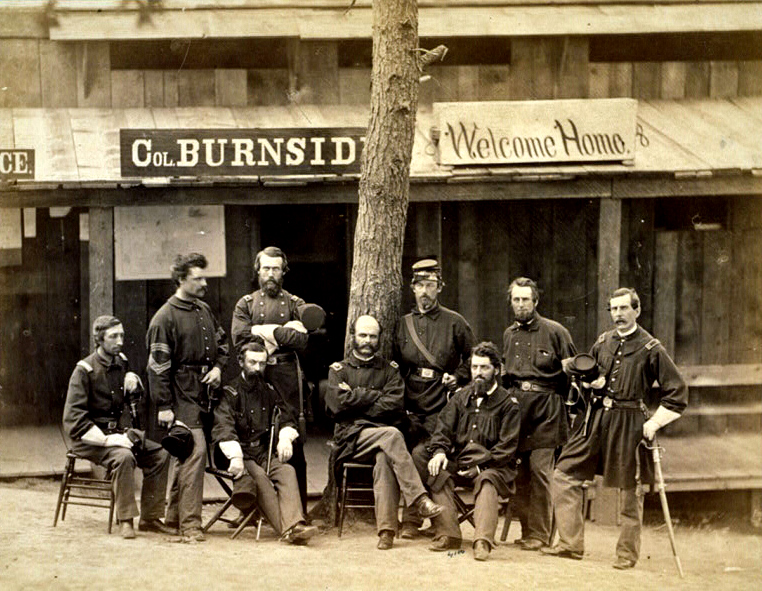About Publications Library Archives
cthl.org

Preserving American Heritage & History

Preserving American Heritage & History


If there is any mitigating circumstance in the failure of Ambrose E.Burnside as commander of the Army of the Potomac it is that he had twice previously refused the post, recognizing his own inexperience, and only accepted at the urging of others who said he had to obey the assignment order.
An Indiana native and West Pointer (1847), he served six years in the regular artillery, including garrison duty in Mexico and being wounded in an 1849 fight with Apaches in New Mexico Territory. Resigning in 1853 to manufacture his breech-loading carbine, he settled in Rhode Island but failed to gain a government contract and had to assign his patent to creditors. During this period he was also a major general in the state militia.
After leading his brigade creditably in the flank attack at 1st Bull Run, he was mustered out with his three-months regiment on August 2, 1861. Four days later he was commissioned a brigadier general and organized an expedition against the North Carolina coast.
For his successes at Roanoke Island and New Bern he was awarded a second star and was offered command of the main Union army following McClellan’s failure on the Peninsula. Refusing this, he detached part of his corps to the aid of Pope in the 2nd Bull Run Campaign. Again offered command following that debacle, he again declined and was given charge of the lst and 9th Corps during the Maryland operations. He fought at South Mountain and then at Antietam, where his two corps were placed on opposite ends of the Union battle line. He nonetheless remained in wing command over the 9th Corps-a cumbersome arrangement that may explain his slowness in attacking at the Stone Bridge. The delay allowed A. P. Hill’s Confederate division to come up from Harpers Ferry and contain the Union breakthrough. With McClellan’s removal he was assigned to the command of the army. He hesitated but was convinced that he had no alternative but to obey the order. His advance upon Fredericksburg was rapid but later delays, some not his fault, allowed Lee to concentrate along the heights and easily repulse the Union attacks. Upset by the failure of his plan, Burnside declared that he himself would lead an assault by his old corps. He was talked out of it but relations between the commander and his subordinates were strained. Accepting full blame, he offered to retire but this was refused.
The next month he launched his ill-fated “Mud March,” which bogged down before it was fairly underway. This time he asked that several officers be relieved of duty and court-martialed and also offered to resign. The latter was accepted; the former not. Lincoln was unwilling to lose him and assigned him to the Department of the Ohio. Here Burnside dealt with copperheads like Clement Vallandigham and Confederate raiders such as John Hunt Morgan. He advanced to Knoxville and was besieged there by Confederate General James Longstreet until a column under Sherman came to his relief. For his stand at Knoxville Burnside received the Thanks of Congress on January 28, 1864. Taking his freshly recruited 9th Corps back to Virginia, he fought directly under Grant-instead of being assigned to the Army of the Potomac because Meade was his junior during the early part of the Overland Campaign. This cumbersome arrangement was soon rectified. He fought at the Wilderness and Spotsylvania where he did not shine, appearing reluctant to commit his troops after the Fredericksburg experience. After North Anna and Cold Harbor he took his place in the siege lines at Petersburg where he bungled the follow-up to the explosion of the mine. In reaction to this failure he was sent on leave and never recalled. He finally resigned on April 15, 1865. After his resignation he occupied numerous railroad and industrial directorships. During the course of his career, he was elected three times governor of Rhode Island (1866-’67-’68). In 1874 he was elected a US Senator from Rhode Island and served until his death at Bristol, Rhode Island, on September 13, 1881. His buried in Swan Point Centary, Providence, Rhode Island. Another of his legacies is the term “sideburns,” which originated from his peculiar whiskers.
(Poore, B.P., The Life and Public Services of Ambrose E. Burnside, and Woodbury, Augustus, Major General Ambrose E.Burnside and the Ninth Army Corps)